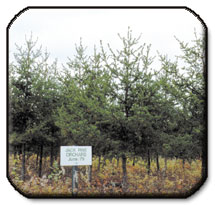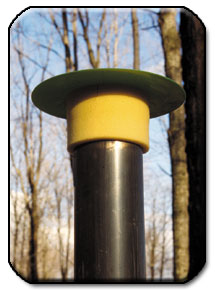
March 2003
 Hybrid
poplar: Reducing spacing to increase yield Hybrid
poplar: Reducing spacing to increase yield
 Over
the past 20 years, there has been significant
progress in cultivation of hybrid poplars as a short rotation crop
in North America and Europe. This practice makes it possible to
reduce the costs of producing timber and bring the raw material
closer to plants. Foresters increasingly count on this type of crop
to increase biomass production. Over
the past 20 years, there has been significant
progress in cultivation of hybrid poplars as a short rotation crop
in North America and Europe. This practice makes it possible to
reduce the costs of producing timber and bring the raw material
closer to plants. Foresters increasingly count on this type of crop
to increase biomass production.
Hybrid poplars can make a significant biomass contribution
in the short term. Work conducted by a researcher at the Canadian
Forest Service on hybrid poplar DN-74 revealed that slightly modifying
the planting space between trees may increase biomass production
per hectare.
For example, according to results obtained for
a cutting cycle of less than five years, decreasing the space by
less than a quarter of a metre (between 1 m and 0.75 m) could considerably
increase biomass production. The results also show that there is
greater competition for light at the crown level as the space between
trees decreases, but poplar foliage becomes accustomed to the reduction
in the amount of light. However, there was no significant difference
in nutrient use.
For information:
 First
mapping of the white spruce genome First
mapping of the white spruce genome
White spruce grows
all over Canada and is used in the lumber and pulp and paper industries.
It is also the second most important species in terms of reforestation.
In Canada, white spruce has a good genetic diversity, and through
cross-breeding of the different families, significant gains can
be obtained in terms of growth and wood quality.
However, usual selection methods are lengthy because
silvicultural characteristics, such as wood quality, can only be
assessed after about 20 years. Canadian Forest Service researchers,
in collaboration with colleagues at Université Laval, have
developed white spruce genome maps. The maps, which create a profile
of all genes carried by the chromosomes, will help to locate the
genes responsible for characteristics that are important to the
industry, such as wood quality and rapidity of growth.
This will make it easier for breeders to determine
whether the trees chosen have the right characteristics for genetic
improvement. The maps will therefore help speed up the genetic selection
process of white spruce.
For information:
I s
fertilizing necessary to assist reproduction
of jack pine in seed orchards? s
fertilizing necessary to assist reproduction
of jack pine in seed orchards?
Seed orchards
are plantations of clones or seedlings from selected trees. They
are developed for rapid and abundant production of improved seeds
for reforestation.
 Canadian
Forest Service researchers, in collaboration with the Ontario Ministry
of Natural Resources, Saskatchewan Pulp and Paper Ltd. and Weyerhauser
Canada Ltd., looked more specifically at the production of seeds
in jack pine seed orchards in Ontario and Saskatchewan. The aim
of their research was to verify whether the use of nitrogenous fertilizers
and growth hormones favoured seed production in these orchards. Canadian
Forest Service researchers, in collaboration with the Ontario Ministry
of Natural Resources, Saskatchewan Pulp and Paper Ltd. and Weyerhauser
Canada Ltd., looked more specifically at the production of seeds
in jack pine seed orchards in Ontario and Saskatchewan. The aim
of their research was to verify whether the use of nitrogenous fertilizers
and growth hormones favoured seed production in these orchards.
The results helped to show that the nitrogen needs
of male and female cones are not the same. In fact, when nitrogenous
fertilizers are added to the soil to increase production of female
cones, there is either no effect or a reduction in male cones.
Therefore, people in charge of orchards should take
this effect into account before deciding whether to use nitrogenous
fertilizers in their plantations to promote the production of female
cones. Using fertilizer reduces the development of male cones, thereby
reducing pollen production in selected trees, which could lead to
reduced tree reproduction.
When used in the right conditions, growth hormones
combined with nitrogenous fertilizers should help increase the development
of female organs in jack pine. Research also revealed that combining
growth hormones and nitrogenous fertilizers did not increase or
decrease the effects of either.
For information:
 A
new trap to monitor the Bruce spanworm A
new trap to monitor the Bruce spanworm
The Bruce spanworm
is a pest of hardwood trees. It attacks sugar maple and trembling
aspen foliage, and is found across Canada.
The usual method for measuring population variations
to determine whether we are in an epidemic period is to use sticky
bands, which are placed around tree trunks. Female spanworms, which
do not have wings, walk on the strips and get stuck to them, making
it possible to count them.
 Although
this method has been successfully used to count female Bruce spanworms
when populations are low, the sticky bands are often full of males
when populations are high. Although
this method has been successfully used to count female Bruce spanworms
when populations are low, the sticky bands are often full of males
when populations are high.
Canadian Forest Service researchers have developed
a trap that makes it possible to gather Bruce spanworm eggs, and
thus to assess its population. The trap is made of polyurethane
foam placed on a post. This is a very simple and practical technique
because the trap is almost entirely non-saturable. Researchers can
set a large number of traps at the beginning of the season and retrieve
them all at once at the end of the season, which makes sampling
easier, allows for the involvement of maple stand owners and allows
a larger area to be covered.
For information:
 A
new site index? A
new site index?
Measuring the
productivity of a site is an important aspect of forest management.
The most commonly used method is the site index, which is based
on the height and age of dominant trees that make up the stand.
Although measuring with this index is simple and is
widely used and accepted, it cannot be applied to sites where there
are no trees.
To get around this problem, Canadian Forest
Service researchers have developed a new biophysical site index.
This index uses the site’s biophysical data (soil, temperature,
etc.), rather than phytometric data (age and height of dominant
trees). It can therefore be used on all types of site.
For information:
|